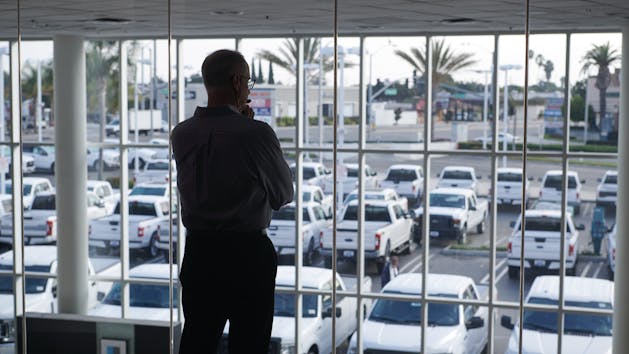Find the right solution for your business with our free Fleet Management Buyer’s Guide.
ELD Short-Haul Exemptions: What You Need to Know
Though the bulk of conversation on compliance and regulatory trends focuses on long-haul, short-haul has its own unique set of challenges. Unlike long-haul, short-haul is often faced with increased levels of city traffic, and drivers have to dedicate valuable time to backup to multiple docks per day.
Short-haul drivers also have to contend with more construction and detours than long-haul. A change in a traffic pattern can drastically impact a short-haul route.
Because short-haul is so demanding, short-haul drivers and dispatchers have increased pressure to work together effectively—as well as consequences for not doing so—using every resource possible to minimize downtime and delays.
In this post, we’ll dive into what qualifies for a short-haul ELD mandate exemption, and what short-haul fleets should consider in deciding whether to take advantage of the ELD exception or use ELD and telematics to their advantage.
The ELD Rule
To clearly outline the exemptions for short-haul, we must first look at the ELD mandate itself.
The Electronic Logging Device (ELD) mandate took effect December 18, 2017, requiring drivers to record duty status and hours compliance using an ELD, and the "hard enforcement" date of April 1, 2018, has now passed as well.
According to the mandate from the FMCSA, a driver’s Record of Duty Status (RODS) can be checked and reviewed by inspection officers at any time, including designated roadside checkpoints.
The stated objective of the ELD rule is to make the roads safer for everyone. According to the FMCSA website, the ELD rule “is intended to help create a safer work environment for drivers, and make it easier and faster to accurately track, manage, and share records of duty status (RODS) data.”
Who is exempt from the ELD rule?
The FMCSA does grant exceptions where they deem the mandate is not appropriate for the use case, industry or specific application.
An exception that spans across a variety of different industries is made for short-haul drivers. According to the FMCSA, “drivers who use the short-haul, timecard exceptions are not required to keep records of duty status (RODS) or use ELDs.”
By nature, short-haul drivers often do not approach the number of hours of long-haul drivers, and they stay within a relatively small radius of their hub.
In addition to the short-haul exception, the following drivers are not required to use ELDs, but they still must document RODS using paper logs, AORBDs, or a logging software program:
- Drivers who are required to keep RODS not more than 8 days within any 30-day period.
- Drivers conducting a drive-away-tow-away operation (an operation in which an empty or unladen motor vehicle with one or more sets of wheels on the surface of the roadway is being transported) if the vehicle being driven is the commodity being delivered, or if the vehicle being transported is a motorhome or recreational vehicle trailer.
- Drivers of vehicles manufactured before the model year 2000.
In addition to these exceptions, the mandate continues to evolve. For example, the FMCSA issued clarification earlier this year on the 150-air-mile exemption from the Hours of Service (HOS) rules for transporting agricultural commodities.
Also earlier this year, the FMCSA added a temporary exemption for motor carriers and drivers involved in Hurricane Michael relief efforts in eight states in an extended regional emergency declaration.
And finally, there are temporary exemptions in place for fleets that were running automatic onboarding recording devices (AOBRDs) that were installed prior to December 18, 2017.
These updates and exemptions are great examples of why fleets cannot simply consider themselves compliant at a single point in time; it is important to continually review your compliance and exemption status.
How to determine if you’re exempt
To determine if you qualify for exemption from compliance with the ELD mandate, you should make certain that you meet all of the requirements of your exception category.
There are a few parameters that define whether or not a driver qualifies as short-haul. CDL drivers qualify as short-haul if you:
- drive only within a 100-air-mile radius
- do not drive more than 11 hours at a time
- maintain time-clock function
- are completely off-duty within 12 hours of the start of the work day
- go back to the same work location every single day
- have at least 10 consecutive off-duty hours between each shift
If you miss any of these requirements on a single day, you are then required to log your hours in a paper logbook. If you break any of the requirements more than eight times during a 30-day period, you are then required to implement an ELD solution.
For drivers who do not have their CDL, the requirements vary slightly. For example, non-CDL short-haul drivers have a 150-air-mile radius, 50 miles more than those drivers holding a CDL.
If you are unsure whether you meet the requirements for a short-haul ELD exemption, you can email ELD@dot.gov or call 1-800-832-5660 for more information.
Optimize your fleet with telematics
If you determine that you are in fact exempt from the ELD rule, there are a variety of reasons that you may still want to implement a telematics solution within your fleet.
What is telematics?
Telematics is the collecting of information relating to mobile assets, such as cars, trucks, or trailers. Many people refer to telematics simply as “GPS vehicle tracking,” but it’s more than just location reporting.
While one of the features of a comprehensive telematics solution is the ability to integrate an ELD-compliant solution, the benefits of telematics extend far beyond ELD alone.
A telematics solution can alert you when a driver is speeding, let you know when a vehicle is not where it should be, update you on idling status, and allow you to send near route-change alerts to drivers.
Reduce fuel costs
By tracking your drivers’ behaviors, telematics helps you identify areas of waste and act upon them accordingly, helping to reduce fuel costs. You’ll also be able to plan the most efficient route for each of your drivers, helping to minimize any unnecessary miles. Especially in short-haul, strategic routing can make all the difference in overall productivity for the day.
Boost productivity
It’s well-known that, especially in logistics, time is money. Up-to-the-minute traffic data can help your drivers avoid delays, as well as give you the ability to easily dispatch new jobs to the nearest vehicle and provide the most efficient route. This is especially important in short-haul, where drivers are often concentrated within city limits and have to contend with increased traffic and construction as compared to long-haul.
Save money on maintenance
Especially in short-haul where vehicles start and stop all throughout the day, regular maintenance is often required more frequently than in long-haul. With a telematics solution, you can set maintenance alerts based on mileage, engine use or time, especially based on your short-haul routes. This, coupled with information on driver behavior, allows you to monitor the wear and tear on your vehicles in order to plan and carry out preventive maintenance.
Improve safety
At the end of the day, it all comes down to safety. With constant feedback about driving style and behavior, fleet managers are in a better position to coach or retrain drivers about bad habits, such as speeding and late braking. In the event that a vehicle is involved in an accident, the GPS can alert you so that you can respond quickly and efficiently.
To learn more about how a telematics solution can give you the insights you need to transform your business, download our eBook.
Potential consequences of not implementing ELD
Even if you are exempt from the ELD requirements, there remain potential consequences for fleets who decide to not implement ELD.
For example, someone could make the argument that a fleet is partially responsible for a short-haul driver who regularly goes beyond their air-mile radius or who regularly exceeds their hours of service.
It remains to be seen whether the lack of an ELD or telematics solution, despite an exception, will expose fleets to legal liability in the event of an accident.
Rather than leaving yourself open to potential liability, implementing a telematics solution conveys that you take vehicle visibility and fleet safety seriously.
If you want to learn more about the state of the industry post-ELD mandate, check out this webinar recording: Life after ELD.
Who should consider ELD
Even for those fleets that meet the requirements for an ELD exemption today, the following categories of fleets should especially consider implementing a telematics solution:
1. If you plan to grow your business
If you are currently growing or plan to grow within the next year, you may want to consider implementing an ELD or telematics solution today. Going through the initial implementation is often easier with a smaller number of vehicles and drivers. Then, you can easily scale the solution as you grow.
2. If you’re actively working to mitigate CSA violations
Despite being exempt from the ELD requirements, implementing a telematics solution across your fleet can contribute to your total CSA score by making you more aware of all activities with your fleet, such as frequent speeding or hard braking.
3. If you have multiple drivers
If you have multiple drivers or vehicles, you are more likely to see the financial return quickly from implementing a telematics solution.
To learn more about the industries that are benefiting from the use of telematics, visit verizonconnect.com/industries.
So now what?
The important thing to remember is that when it comes to fleet safety and FMCSA compliance, you can’t take a “once and done” approach. As seen in the addition of the 150-mile-radius exemption for agriculture, as well as the exceptions made for hurricane relief efforts, regulations and requirements are always evolving.
With around-the-clock fleet tracking, you can effectively manage unsafe behavior, reduce your maintenance costs, and boost productivity and efficiency within your short-haul routes.
The information contained in this document may or may not be correct and/or complete at the time of reading and is not intended to be used as a substitute for specific professional or legal advice or opinions. No recipients of content from this documents should act or refrain from acting on the basis of content of the document without seeking appropriate legal advice or other professional counseling. Verizon Connect expressly disclaims all liability relating to actions taken or not taken based on any or all contents of this document.
Find out how our platform gives you the visibility you need to get more done.




